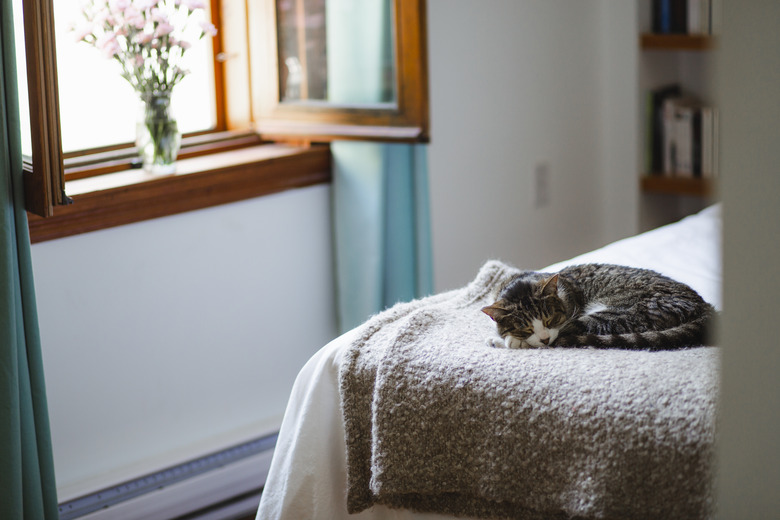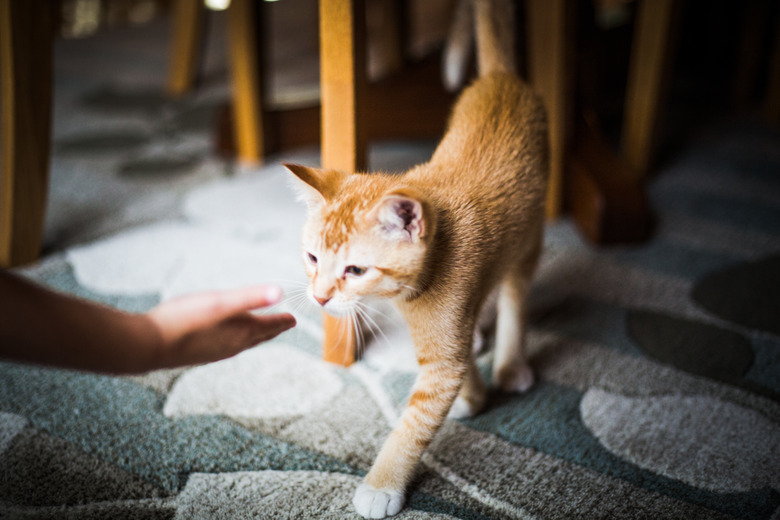How To Comfort A Scared Cat
There may be nothing more alarming to a pet parent than a scared cat. When your cat is scared, they may hide or even attack. This can leave many of us wondering about the best way to comfort our distressed cats.
When cats become frightened, they often respond in one of three ways: flight, fight, or freeze. This according to the team with paws — a wildlife rescue and domestic animal companion shelter based in Washington State. Common signs of fear in cats include:
- Hiding
- Freezing in place
- Loss of control over bladder and/or bowels
- Aggression: Including hissing, growling, swatting, biting, or scratching
- Piloerection: Hair standing on end
So, what's the best way to comfort a scared cat? While the answer depends on the situation, there are a few techniques that are generally accepted to be best practices:
- Remain calm
- Move slowly
- Respect your cat's space
- Do not pick up or pet your cat unless they signal you to do so
- Do not follow your cat
Does comforting a scared cat reinforce fear?
Does comforting a scared cat reinforce fear?
Some pet parents worry that comforting a scared cat will reinforce a fear response. This is most likely due to popularly held, yet outdated, beliefs about how to best respond to a distressed pet. Still, there is no evidence to suggest that providing special attention to a scared cat will reinforce a fear reaction, according to a study cited by the experts at Whole Dog Journal.
The study's authors highlight a difference between "avoidance learning" and "reinforcing fear" — two dynamics that are often confused. Essentially, unlike "undesirable behavior," stress and fear are emotional responses that both cats and humans do not choose to have. Therefore, being natural reactions, we do not reinforce stress and fear when we alleviate these emotions.
Common fear triggers for cats
Common fear triggers for cats
Your cat may become fearful or feel threatened for a variety of reasons. We've rounded up some of the most common triggers that cause fear in cats along with the best ways to comfort your pet when they are distressed. Several of the more common feline fear triggers include:
- Sudden movement
- Strangers, frequently children
- Other animals
- Loud noises, especially fireworks
- New homes
- Veterinary visits
How to comfort a cat in a new home
How to comfort a cat in a new home
New homes will often cause cats stress. However, the staff at Michigan's Humane Society of Huron Valley say that by following a few helpful steps, you can successfully comfort a cat who is scared of their new home.
- Create a "home base" for your cat in its new home. Include items like a food dish, water bowl, litter box, cat bed, and toys. Begin by only introducing your cat to "home base" first. This allows them to become familiar with the environment.
- Keep your cat safely at "home base" until they show signs of wanting to explore other areas of the home. This could take hours, or it may take days.
- Let your kitty explore the rest of the home slowly, over time, and avoid overwhelming them with too much too soon. Consider allowing your cat access to only one new room at a time.
If you've recently adopted a new cat, our guide to introducing a cat to a new home will help your moggie get comfortable in their new environment.
How to reduce the stress of veterinary visits for cats
How to reduce the stress of veterinary visits for cats
While there are exceptions, most cats prefer the routines of home life and don't care much for traveling outside of their territories. Yet, there is one place your cat will need to visit occasionally — the veterinarian. And, both the journey and the destination can be a cause of anxiety for your cat.
"Veterinarians recommend the use of a carrier for travel because it is the safest and most secure way to transport animals," writes Tammy Hunter, DVM, with VCA animal hospitals. Hunter also points out that the crate also serves as a safe space for your cat — providing them with familiarity and territory.
How to comfort a scared cat who is frightened of strangers
How to comfort a scared cat who is frightened of strangers
It's common for cats to feel threatened or fearful when strangers enter the home. Thankfully, you can help your cat feel confident and safe — according to the rescuers at a Best Friends Animal Sanctuary. You'll need to recruit a friend to be "the stranger" in this exercise. Follow these steps to comfort a scared cat:
- Begin with you and your cat in the same room, preferably a large one. Then ask "the stranger" to slowly enter the far end of the room (or even the connecting room or hallway). The stranger should not give your cat eye contact. The distance between stranger and cat will vary depending on your kitty's comfort level, but your cat should not be anxious — this is the safe starting distance.
- Reward your cat when they stay calm. Slowly shorten the safe starting distance, over time, with additional sessions.
- If your cat does not remain calm, then it's time to end the session and try again in several minutes. You may be able to gently coax them back into the room with a treat and give the session a second try. It's normal for a cat to end these sessions quickly at first.
- Begin additional sessions at the safe starting distance. But the overall goal is to get your cat comfortable with a single stranger. It may take several weeks and dozens of attempts, but your cat will become more confident. At some point, you may even invite more than one "stranger" for advanced sessions.
How to comfort a cat who is scared of sudden movements
How to comfort a cat who is scared of sudden movements
The team at the SPCA of Martinsville and Henry County in Virginia suggests a behavior modification exercise to calm cats who are fearful of sudden movements.
- Decide on a starting gesture. This motion should be one that your cat does not find threatening. For example, perhaps your cat is less fearful when you slowly reach your hand several inches away from them or when you get up from the couch.
- When your cat is occupied by play or mealtime, deploy your starting gesture. When your friend stays calm, reward them. Repeat the exercise for several minutes at a time, and, after several sessions, your cat should become more comfortable with the sudden movement of your starting gesture.
- Gradually increase the size or intensity of the starting gesture. Perhaps your reach becomes slightly quicker over time or you get up from the couch a bit faster. Again, watch for signs of distress and reward calm behavior with treats.
- If your cat becomes anxious, dial back the intensity. Remember, the point is to slowly get your cat comfortable with sudden movements. So when they reach their threshold, be respectful of the boundary by reducing the starting gesture's intensity and trying again later.
- Becoming familiar with sudden movements is a process. Be patient with your cat. Positive behavior modification does not happen overnight, and you may need to repeat the process multiple times to allow your cat the time they need to become more confident.
In summary
In summary
Cats become fearful for a variety of reasons, and the best way to comfort your scared cat will depend on the situation. However, a few stand-out techniques apply in nearly all circumstances. These include remaining calm, moving slowly, and respecting your cat's space by not following them, picking them up, or petting them until they are ready.




